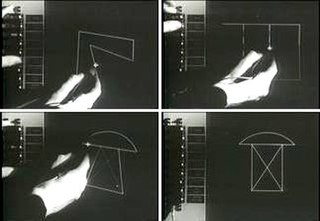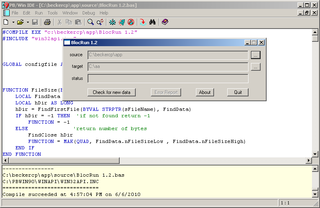
The history of the graphical user interface, understood as the use of graphic icons and a pointing device to control a computer, covers a five-decade span of incremental refinements, built on some constant core principles. Several vendors have created their own windowing systems based on independent code, but with basic elements in common that define the WIMP "window, icon, menu and pointing device" paradigm.

Windows 95 is a consumer-oriented operating system developed by Microsoft as part of its Windows 9x family of operating systems. The first operating system in the 9x family, it is the successor to Windows 3.1x, and was released to manufacturing on August 15, 1995, and generally to retail on August 24, 1995. Windows 95 merged Microsoft's formerly separate MS-DOS and Microsoft Windows products, and featured significant improvements over its predecessor, most notably in the graphical user interface (GUI) and in its simplified "plug-and-play" features. There were also major changes made to the core components of the operating system, such as moving from a mainly cooperatively multitasked 16-bit architecture to a 32-bit preemptive multitasking architecture, at least when running only 32-bit protected mode applications.

PowerBASIC, formerly Turbo Basic, is the brand of several commercial compilers by PowerBASIC Inc. that compile a dialect of the BASIC programming language. There are both MS-DOS and Windows versions, and two kinds of the latter: Console and Windows. The MS-DOS version has a syntax similar to that of QBasic and QuickBASIC. The Windows versions use a BASIC syntax expanded to include many Windows functions, and the statements can be combined with calls to the Windows API.
The Windows API, informally WinAPI, is Microsoft's core set of application programming interfaces (APIs) available in the Microsoft Windows operating systems. The name Windows API collectively refers to several different platform implementations that are often referred to by their own names ; see the versions section. Almost all Windows programs interact with the Windows API. On the Windows NT line of operating systems, a small number use the Native API.
DirectDraw (ddraw.dll) is a deprecated API that used to be a part of Microsoft's DirectX API. DirectDraw is used to accelerate rendering of 2D graphics in applications. DirectDraw also allows applications to run fullscreen or embedded in a window such as most other MS Windows applications. DirectDraw uses hardware acceleration if it is available on the client's computer. DirectDraw allows direct access to video memory, hardware overlays, hardware blitters, and page flipping. Its video memory manager can manipulate video memory with ease, taking full advantage of the blitting and color decompression capabilities of different types of display adapters.
The Graphics Device Interface (GDI) is a legacy component of Microsoft Windows responsible for representing graphical objects and transmitting them to output devices such as monitors and printers. Windows apps use Windows API to interact with GDI, for such tasks as drawing lines and curves, rendering fonts, and handling palettes. The Windows USER subsystem uses GDI to render such UI elements as window frames and menus. Other systems have components that are similar to GDI; for example: macOS has Quartz and X Window System has Xlib/XCB.
The BMP file format, also known as bitmap image file, device independent bitmap (DIB) file format and bitmap, is a raster graphics image file format used to store bitmap digital images, independently of the display device, especially on Microsoft Windows and OS/2 operating systems.
In computing, WinG is an application programming interface that was designed to provide faster graphics performance on Windows 3.x operating environments, and was initially positioned as a way to help game developers more easily port their DOS games to Microsoft Windows, although it was quickly discontinued in favor of DirectX.

Windows NT 4.0 is a major release of the Windows NT operating system developed by Microsoft and oriented towards businesses. It was released to manufacturing on July 31, 1996, and was launched to retail on August 24, 1996, exactly one year after the release of its MS-DOS equivalent, Windows 95. It was Microsoft's primary business-oriented operating system until the introduction of Windows 2000. Workstation, server and embedded editions were sold; all editions feature a graphical user interface similar to that of Windows 95.
Windows USER is a component of the Microsoft Windows operating system that provides core functionality for building simple user interfaces. The component has existed in all versions of Windows, and includes functionality for window management, message passing, input processing and standard controls.

The architecture of Windows NT, a line of operating systems produced and sold by Microsoft, is a layered design that consists of two main components, user mode and kernel mode. It is a preemptive, reentrant multitasking operating system, which has been designed to work with uniprocessor and symmetrical multiprocessor (SMP)-based computers. To process input/output (I/O) requests, they use packet-driven I/O, which utilizes I/O request packets (IRPs) and asynchronous I/O. Starting with Windows XP, Microsoft began making 64-bit versions of Windows available; before this, there were only 32-bit versions of these operating systems.
Dynamic-link library (DLL) is Microsoft's implementation of the shared library concept in the Microsoft Windows and OS/2 operating systems. These libraries usually have the file extension DLL, OCX, or DRV . The file formats for DLLs are the same as for Windows EXE files – that is, Portable Executable (PE) for 32-bit and 64-bit Windows, and New Executable (NE) for 16-bit Windows. As with EXEs, DLLs can contain code, data, and resources, in any combination.
Desktop Window Manager is the window manager in Windows Vista, Windows 7, Windows 8, Windows 10, and Windows 11 that enables the use of hardware acceleration to render the graphical user interface of Windows.
UniDrv is a GDI-based Microsoft Windows universal printer driver and architecture for non-PostScript printers. It is used to simplify driver development of non-PostScript printers for printer manufacturers. Unidrv allows the creation of a printer-specific minidriver in the form of a GPD file, similar to a PPD file, which is much simpler than kernel mode driver development. Unidrv was introduced in Windows 2000 and replaced the Raster Device Driver (RASDD) interface used in Windows NT 4.0 and earlier versions.
Windows Display Driver Model (WDDM) is the graphic driver architecture for video card drivers running Microsoft Windows versions beginning with Windows Vista.
The Microsoft Windows operating system supports a form of shared libraries known as "dynamic-link libraries", which are code libraries that can be used by multiple processes while only one copy is loaded into memory. This article provides an overview of the core libraries that are included with every modern Windows installation, on top of which most Windows applications are built.
Client Server Runtime Subsystem, or csrss.exe, is a component of the Windows NT family of operating systems that provides the user mode side of the Win32 subsystem and is included in Windows NT 3.1 and later. Because most of the Win32 subsystem operations have been moved to kernel mode drivers in Windows NT 4 and later, CSRSS is mainly responsible for Win32 console handling and GUI shutdown. It is critical to system operation; therefore, terminating this process will result in system failure. Under normal circumstances, CSRSS cannot be terminated with the taskkill command or with Windows Task Manager, although it is possible in Windows Vista if the Task Manager is run in Administrator mode. On Windows 7 and later, Task Manager will inform the user that terminating the process may result in system failure, and prompt if they want to continue. In Windows NT 4.0 however, terminating CSRSS without the Session Manager Subsystem (SMSS) watching will not crash the system.(at 0:31) However in Windows XP, terminating CSRSS without SMSS watching will crash the system due to the critical bit being set in RAM for csrss.exe.
In computing, a bitmap is a mapping from some domain to bits. It is also called a bit array or bitmap index.
Direct2D is a 2D vector graphics application programming interface (API) designed by Microsoft and implemented in Windows 10, Windows 8, Windows 7 and Windows Server 2008 R2, and also Windows Vista and Windows Server 2008.




